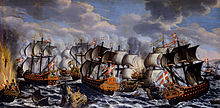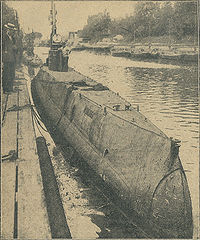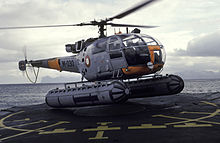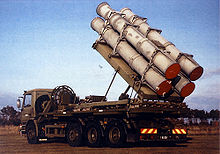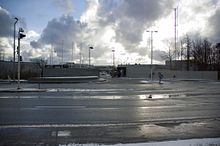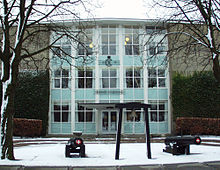- Royal Danish Navy
-
This article is about the Royal Navy of Denmark. For other Royal Navies, see Royal Navy (disambiguation).
Royal Danish Navy
Søværnet
Logo of "Søværnet"Founded 1510 (1401) Country  Denmark
DenmarkSize 3,400 personnel + 200 conscripts[1]
16 ships, 28 vessels and 30 boats[2]Part of Military of Denmark Engagements Swedish War of Liberation (1510-23)
Count's Feud (1534-36)
Nordic Seven Years' War (1563-70)
Kalmar War (1611-13)
Torstenson War (1643-45)
Second Nordic War (1657-60)
Scanian War (1675-79)
Great Nordic War (1700 & 1709-20)
Punitive expedition against Barbary (1769-70)[3]
Battle of Copenhagen (1801)
Battle of Copenhagen (1807)
Gunboat War (1807-14)
First Schleswig War (1848-51)
Second Schleswig War (1864)
Operation Desert Shield (1990-91)
Operation Sharp Guard (1993-96)
Operation Iraqi Freedom (2003)
Combined Task Force 150 (2008- )Commanders Chief of Defence General Knud Bartels Chief of Admiral Danish Fleet Rear Admiral Finn Hansen Notable
commandersPeter Tordenskjold, Ivar Huitfeldt, Niels Juel, Herluf Trolle, Olfert Fischer Insignia  Flag of the Royal Danish Navy. Ratio: 56:107
Flag of the Royal Danish Navy. Ratio: 56:107
The Royal Danish Navy (RDN) (officially Kongelige Danske Marine in Danish but generally known as Søværnet or 'Sea Defence') is the sea-based branch of the Danish Defence force. The RDN is mainly responsible for maritime defence and maintaining the sovereignty of Danish, Greenlandic and Faroese territorial waters. Other tasks include surveillance, search and rescue, icebreaking, oil spill recovery and prevention as well as contributions to international tasks and forces.
During the period 1509-1814 when Denmark was in union with Norway, the Danish Navy was part of the Royal Dano-Norwegian Navy. Until the copenhagenization of the navy in 1807 the navy was a major strategic influence in European geographical area, but since then it had remained of a smaller size. Despite this the navy is now equipped with a number of large state-of-the-art vessels commissioned since the end of the Cold War. This can be explained by its strategic location as the NATO member controlling access to the Baltic.
Danish Navy ships carry the prefix KDM (Kongelige Danske Marine) in Danish, but this is translated to HDMS (Her / His Danish Majesty's Ship) in English. Denmark is one of several NATO member states whose navies do not deploy submarines.
Contents
History
The geographic layout of Denmark (not including Greenland and the Faroe Islands) has a coastline to land area ratio of 1:5.9. By comparison, the figure for the Netherlands is 1:92.1 and for the USA, 1:493.2[4] Denmark therefore naturally has long-standing maritime traditions, dating back to the 9th century when the Vikings had small but well-organised fleets. They were often based in a small number of villages, usually with a common defence agreement. As the Viking ships, usually of the Knarr type, were light, and therefore easy to transport from village to village over land. With time, the defence pacts gave rise to larger, more offensive fleets which the Vikings used for plundering coastal areas. In the period after the Vikings and up to the 15th century, the fleet consisted mainly of merchant vessels. Indeed, it is said that king Valdemar Sejr had more than 1,000 ships during the conquest of Estonia in 1219. Together they carried more than 30,000 soldiers with horses and supplies.
Records exist of a unified Danish navy from the late 14th century. Queen Margaret I, who had just founded the Kalmar Union (consisting of Denmark, Norway, Sweden, Iceland, Greenland, Faroe Islands, Shetland, Orkney, parts of Finland and parts of Germany) ordered the building of a navy — mainly to defend the union against the Hanseatic League. Earlier the national fleet had consisted of vessels owned and operated by the nobility, but the country as such did not have a navy. The earlier monarchs therefore had to rely on conscription from the nobility, which was not always easy as the monarchy itself often had enemies within the nobility. Queen Margaret I gave instructions for a navy to be constituted and maintained under the control of the monarchy. The nobility still had to provide crews (which consisted mainly of "volunteered" farmers) for these ships, though the core crew-members (i.e. masters, master-at-arms and master carpenters) could be employed by the monarch. There were also education officers, mainly levied from the nobility.
In the 15th century, especially during the reign of King Hans, Danish trade expanded appreciably, increasing the need for the delivery of merchandise. As shipping was the ideal means of transport at the time, Danish maritime interests had to be further protected. King Hans is credited with establishing the Common Fleet in 1509, substantially increasing the number of professional crewmembers. They were mainly petty criminals, who had to choose between working in the king’s navy or imprisonment. They received basic training in seamanship and carpentry enabling them to sail the ships. Responsibility for weaponry and combat was still in the hands of conscripted farmers. For these, the country was divided into a number of counties — known in Danish as skipæn (the term skip being related to the Danish word for ship, skib), which would later serve as the Danish dioceses. It was also during this period that dedicated naval bases and shipyards were founded. They would build, maintain and fit out the king’s navy. The first record of a dedicated naval base is Bremerholmd (later Gammelholm) in the year 1500.
The founding of the Danish navy is often viewed in Denmark as taking place on 10 August 1510 when King Hans appointed his vassal Henrik Krummedige to become "chief captain and head of all our captains, men and servants whom we now have appointed and ordered to be at sea." [5][6]
When King Frederick II was crowned in 1559, he immediately began expanding the navy further. The number of bases, yards and vessels rose rapidly and substantial resources were used for new ship designs, weaponry, training and battle tactics. Sweden, which had become an independent country, dominated a large part of the Baltic Sea, threatening Danish merchant interests. In retaliation, Denmark closed the Øresund in 1568, laying the first seeds for the Scanian War (1675–1679), only eight years after the end of the second Nordic War (1657–1660), during which Denmark lost the now Swedish provinces of Skåne, Halland and Blekinge. During this period further resources were allocated to the navy. Cort Adler and Niels Juel led the Danish navy to a victory in the Battle of Køge Bay in 1667.
King Christian IV (crowned in 1588) continued in his father's footsteps. In the beginning of the 17th century, he considerably expanded the naval workships. In Copenhagen, where the navy resided, he built a large number of homes for crewmembers and workshop craftsmen — the most famous being Nyboder (completed in 1631) which still stands in central Copenhagen.
General admiral lieutenant Ulrik Christian Gyldenløve was appointed supreme commander of the navy in 1701. He raised the status of the naval profession and established Søkadetakademie, the predecessor of the Royal Danish Naval Academy. In 1709, Peter Jansen Wessel joined the navy. He was later given the rank of admiral as a reward for his many victories - most famously at Marstrand and Dynekilden. He was later known as Tordenskjold.
In 1712, Tordenskjold succeeded in burning 80 Swedish naval cruisers. This played a large part in the outcome of the Great Nordic War (1709–1720). Since Scandinavia now was at peace, the navy focused its resources on other parts of the world, resulting in colonisation of Africa and the Caribbean. A permanent naval presence of shifting strength was maintained in the Mediterranean Sea - protecting Danish-Norwegian interests in the region - mainly commerces against piracy. The Danish Mediterranean Squadron had throughout the seventeen and parts of the eighteen hundreds numerous minor engagements with The Barbary States. On several occasions these hostilities escalated to substantial actions. Some of the more notable, can be said to the Mediterranean Squadrons bombardment of Algiers in 1770 under the command of contreadmiral Frederik Christian Kaas, the then captain, and future Privy Councillor, Steen Andersen Bille's action at Tripoli in 1797, and commander Hans Georg Garde in a joint Scandinavian expedition in 1844 - which effectively ended the Barbary states' attacks on Scandinavian merchants in the region. A pact of neutrality was made between Denmark (including Norway) and Sweden, providing a solid basis for commercial expansion.
The British, under pressure from the French in the Napoleonic Wars, became increasingly reluctant to allow Denmark to trade overseas as they believed Napoleon could benefit economically from Danish commerce. In 1801, they decided to attack a Danish line of defence, in the Battle of Copenhagen, under the command of Admiral Hyde Parker. The defence line, under the command of Olfert Fischer, was far smaller than the attacking force and was easily subdued. Denmark was therefore forced to make an agreement with the British. In the following six years, Denmark managed to stay clear of the Napoleonic Wars, until the events leading to the second Battle of Copenhagen in 1807. Britain was afraid the Danish fleet might fall under the control of Napoleon, perhaps tipping the balance in his favour. King Christian VII refused to hand over his navy to the British for safekeeping until the end of the war, and the British attacked. After the battle, the Bombardment of Copenhagen (from 2 to 5 September) took place under Admiral Gambier. It is generally accepted as the first terror bombardment by a fleet,[7] in which the terrorising of civilians was used to gain a political goal.
In 1814, Denmark and Norway were separated relatively peacefully, after more than 300 years together. At the same time the Common Fleet was split into the Royal Danish Navy and the Royal Norwegian Navy.
The navy was slowly rebuilt, but it was nowhere near its former size. Faith was nevertheless placed in the navy, interests in Africa and the Caribbean still receiving considerable attention. In 1845, a two-year research expedition was launched on the corvette Galathea. In the Second Schleswig War (1864), the navy was still relatively small and old-fashioned. Only a few steam vessels were at hand and these had a large impact on the war. As a result, it was considered necessary for the navy to be modernised. By the outbreak of World War I (1914), the Danish navy was a very modern fleet, mainly equipped with armoured steam ships and only a very few sailing ships.
In the period between the two world wars, the Danish navy (as well as the rest of the Danish military forces) had low priority for the politicians, especially between 1929 and 1942 under Thorvald Stauning. During the first year of the German occupation (1940–1945), the navy, assisted the occupying German forces with minesweeping, because of the political demand of keeping the infrastructure (ferry-lines) up and running. The tensions between the German soldiers and the Danish armed forces rose slowly and on 29 August 1943, they managed to scuttle 32 of its larger ships, while Germany succeeded in seizing 14 of the larger and 50 of the smaller vessels. This was due to a secret order, given directly to the captains by word of mouth by commander of the navy, Vice Admiral A. H. Vedel "to try to flee to the nearest neutral or nazi-opposed port. If that was not possible the ship should be scuttled at as deep a location as possible". The Germans later succeeded in raising and refitting 15 of the sunken ships. During the scuttling of the Danish fleet, a number of vessels were ordered to attempt an escape to Swedish waters, 13 succeeding.[8][9] The score for the larger vessels was therefore: 32 vessels were sunk, 2 were in Greenland, 4 reached Sweden, 14 were captured by the Germans. As for the smaller vessels: 9 "patruljekuttere" reached Sweden, 50 others were captured by the Germans.[9] By the autumn of 1944, these ships officially formed a Danish naval flotilla in exile.[10] In September 1943, A. H. Vedel was fired by order of the prime minister Vilhelm Buhl, because of his hostile actions towards the Germans. In November 1943, the Swedish authorities allowed 500 Danish soldiers in Sweden to train as "police troops". By the autumn of 1944, Sweden raised this number to 4,800 and recognised the entire unit as a Danish military brigade in exile.
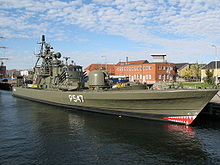 Danish FAC Sehested (Willemoes-class)
Danish FAC Sehested (Willemoes-class)
Carrying Harpoon-missiles and FFV Type 613 21" torpedoes. Top-speed 45 kn (1972-2000)In the post-war years, Denmark joined NATO in 1949. As a result, Denmark received large amounts of material and financing through the Marshall Plan. Furthermore several ships was purchased from the British and a number of vessels were transferred from the now disarmed German navy.
During the Cold War, the Danish navy was rebuilt and modernised, the main assignment being to repel an invasion from the Warsaw Pact. Typical operations requiring training were minelaying (the now disbanded minelayers of the Falster-class (17 kn, 2,000 GRT), was the worlds largest minelayers at their time - each had a complement of 280 900 kg mines) and sting attacks with small but fast combat craft (such as the Søløven-class torpedo boats (54 kn, 158 GRT) and Willemoes-class missile torpedo boats (45 kn, 260 GRT) and a self-sustaining mobile missile battery (MOBA) equipped with targeting and guidance, capable of firing Harpoon missiles.[11] The Danish intelligence capabilities were also expanded and the Danish submarines trained for very shallow water operations, while a special naval force - the Danish Frogman Corps was created. The naval bases in Frederikshavn and Korsør plus the fortresses at Langeland and Stevns were created through NATO funds in the 1950s.
Since the end of the Cold War, the navy has been in a transitional phase, from local defence to global operations, with fewer but larger vessels able to operate for long periods at sea. It has also been more self-sustaining. Under the defence agreement (1995–1999) which initiated the process, several of the old "cold war" frigates and minesweepers were decommissioned. The squadron structure prior to this defence agreement was as follows:
- 1st Squadron = The North Atlantic Squadron (Danish: 'InspektionsSkibsEskadren' (ISE)) with 5 ocean patrol vessels (1 Beskytteren-class, 4 Thetis-class), 3 ocean patrol cutters (Agdlek-class) and 4 icebreakers
- 2nd Squadron = The Frigate Squadron (Danish: 'FreGatEskadren' (FGE)) with 2 frigates (Peder Skram-class), 3 corvettes (Niels Juel-class), 14 StanFlex-vessels (Flyvefisken-class) and 6 seaward defence craft (Daphne-class, decommissioned in 1991)
- 3rd Squadron = The Mine Squadron (Danish: 'MineSkibsEskadren' (MSE)) with 4 minelayers (Falster-class), 2 cable-minelayers (Lindormen-class) and 7 minesweepers (Sund-class, decommissioned in 1999)
- 4th Squadron = The Torpedo Boat Squadron (Danish: 'TorpedoBådsEskadren' (TBE)) with 13 torpedo-/missile boats (8 Willemoes-class, 5 Søløven-class), 2 oilers (Faxe-class) and a truck-detachment with missiles and radars called MOBA
- 5th Squadron = The Submarine Squadron (Danish: 'UndervandsBådsEskadren' (UBE)) with 6 submarines (3 Tumleren-class, 3 Springeren-class) and the Frogmans Corps
In the defence agreement of 2000-2004, further restructuring of the navy was ordered, as well as the decommissioning of several units. Furthermore the only unit of Beskytteren-class was donated to the Estonian Navy as Admiral Pitka (A230). With the decommissioning of the torpedo boats, the 4th squadron was disbanded and the remnants were transferred to the 2nd squadron. Other units were also decommissioned. The squadron structure now looked like this:
- 1st Squadron with 4 ocean patrol vessels (Thetis-class), 3 ocean patrol cutters (Agdlek-class) and 3 icebreakers
- 2nd Squadron with 3 corvettes (Niels Juel-class), 14 StanFlex-vessels (Flyvefisken-class), 2 oilers (Faxe-class) and a truck-detachment with missiles and radars called MOBA and a new truck-unit MLOG with shops, spare parts, mechanics, etc.
- 3rd Squadron = The Mine Squadron (Danish: 'MineSkibsEskadren' (MSE)) with 4 minelayers (Falster-class) and 2 cable-minelayers (Lindormen-class)
- 5th Squadron = The Submarine Squadron (Danish: 'UndervandsBådsEskadren' (UBE)) with 4 submarines (3 Tumleren-class, 1 Kronbrog-class - leased Swedish Näcken-class) and the Frogman Corps
On 1 January 2006, a major reorganisation was carried out as a part of the defence agreement of 2005-2009 (which also put an end to the 95 year old submarine service, with no intention of developing future submarine capability), when the former four squadrons were divided into two squadrons:[12]
- 1st Squadron - domestic affairs squadron
- 2nd Squadron - foreign affairs squadron
Admiral Danish Fleet
The Admiral Danish Fleet (in Danish Søværnets Operative Kommando), led by a Rear Admiral, is directly responsible to the Danish Defence Command.
The squadrons
The Danish fleet today is divided into two squadrons:
- 1st Squadron, administratively based at Naval Base Frederikshavn, handles all tasks regarding domestic affairs, such as maritime defence and sovereignty of Danish, Greenlandic and Faroese territorial waters, surveillance, search and rescue, icebreaking and oil spill recovery and prevention. It has provided units for international tasks, such as the environmental recovery vessel Gunnar Seidenfaden for the cleanup after the Prestige oil spill and the ocean patrol vessel Thetis for the protection force programme of WFP chartered ships at the Horn of Africa. Vessels operated by 1st Squadron.
- 2nd Squadron, administratively based at Naval Base Korsør, is specialized in foreign affairs. It conducts exercises for participation in various international tasks, such as providing protection force, disaster relief operations and non-combatant evacuation operations. It permanently provides units for international standing maritime groups as well as supporting various maritime operations. Vessels operated by 2nd Squadron.
The Naval Operational Logistic Support Structure (OPLOG), including the naval bases in Frederikshavn and Korsør as well as several naval stations.
The naval bases' task is to provide logistic support for the ships and vessels, through the OPLOGs. This includes configuration, maintaining and repairing the units. Furthermore similar support is provided to civilian agencies (i.e. the Danish police) and allied units like United nations
The support is mainly provided within the geographical areas of the naval bases. For Naval Base Korsør that is Zealand, Funen, Bornholm as well as the surrounding waters. For Naval Base Frederikshavn it is Jutland, Greenland and the Faroe Islands. Furthermore general support is provided for units participating in international operations in peacetime, as well as all units in crisis and wartime.
The navy maintains a number of naval stations. These are smaller stations with limited support functions. The best known is the publicly accessible Naval Station Holmen in Copenhagen. There are also naval stations located in Esbjerg, Kongsøre, on Møn, in Århus and Lyngsbæk.
Special forces units
 A visit, board, search and seizure team, mainly composed of personnel from the Frogman Corps, entering USS Vella Gulf
A visit, board, search and seizure team, mainly composed of personnel from the Frogman Corps, entering USS Vella Gulf
The navy operates two special operation units.
The Frogmen Corps
The Frogmen Corps (Danish: Frømandskorpset) is an elite special force unit with the tasks of reconnaissance, assaulting enemy ships, sabotage of fixed installations as well as anti-terrorism work with the police.
Sirius Arctic Patrol
The Sirius Arctic Patrol is a special forces unit and dog sled patrol conducting long-range reconnaissance (LRRP) and enforcing Danish sovereignty as well as representing Denmark's military presence in Greenland.
Danish Task Group
Main article: Danish Task GroupThe Danish Task Group is a mobile unit that is experienced in orchestrating exercises, organising insertions (search and rescue, non-combatant evacuation, disaster relief operations, etc.) and commanding naval, aerial and land-based units. It is composed of personnel from the Danish army, navy, air force and foreign ministry.
Runs three main schools, with five special schools:
- Naval NCO and Basic Training School (Danish: Søværnets Sergent- og Grundskole (SSG)) near Frederikshavn
- Danish naval academy (Danish: Søværnets Officersskole) on Holmen
- naval specialist schools (Danish: Søværnets specialskoler):
- Naval Warfare School (Danish: Søværnets Taktikkursus (TAK)) at Naval Base Frederikshavn and Holmen
- Naval Weapons School (Danish: Søværnets Våbenkursus (SVK)) on Sjællands Odde
- Naval Technical School (Danish: Søværnets Teknikkursus (TEK)) on Holmen
- Naval Damage Control School (Danish: Søværnets Havarikursus (SHK)) near Frederikshavn
- Naval Diving School (Danish: Søværnets Dykkerkursus (SDK)) on Holmen
International operations
The contemporary Danish navy, has participated in the following international operations:
Year Operation Participating units 1990-91 Operation Desert Shield F355 Olfert Fischer (Niels Juel-class) 1993-96 Operation Sharp Guard F354 Niels Juel (Niels Juel-class) 1999 Operation Allied Harvest N43 Lindormen (Lindormen-class) 29 November 2002 - 4 March 2003 Prestige Cleanup A561 Gunnar Seidenfaden (Gunnar Thorson-class) 2003 Operation Iraqi Freedom S323 Sælen (Tumleren-class), F355 Olfert Fischer (Niels Juel-class) 2006-08 United Nations Interim Force in Lebanon (UNIFIL) P557 Glenten, P560 Ravnen (Flyvefisken-class), F356 Peter Tordenskiold (Niels Juel-class) 2007 Standing NRF Maritime Group 1 F355 Olfert Fischer (Niels Juel-class) 2008 WFP protection force at the Horn of Africa F357 Thetis (Thetis-class) 2008 Task Force 150 Danish Task Group and L16 Absalon (Absalon-class) 2009 Flagship SNMCMG1 F357 Thetis (Thetis-class) 2009 Task Force 151 L16 Absalon (Absalon-class) 2010 Flagship SNMG1 L17 Esbern Snare & L16 Absalon (both Absalon-class) Vessels
The Danish navy currently operates 12 larger vessels (displacement > 1,500 t(m)), 4 medium-size vessels (1,500 t(m) > displacement > 500 t(m)) and 38 small vessels (500 t(m) > displacement > 15 t(m)) as well as a number of rigid-hulled inflatable boats, boats etc.
The navy ship programs are generally of the "newer but fewer" type. Many of the vessels are of more recent dates (Absalon-class from 2004–2005, Thetis-class from 1991–1994 and Flyvefisken-class from 1986–1995) or under replacement, i.e. the corvettes of the Niels Juel-class (1978–1980) are under replacement with three new Ivar Huitfeldt-class Frigates currently under construction for 2nd Squadron and the Barsø-class (1969–1973) will be replaced with 6 Diana-class small patrol crafts. Finally two of the three Agdlek-class (1973–1979) will be replaced with the new Knud Rasmussen-class vessels.
Aerial vehicles
From 1981 to 2011-01-01 the Royal Danish Navy operated Westland Lynx in various configurations. These helicopters relieved the previous fleet of Alouette III helicopters. By the end of their service in the navy, the fleet consisted of 8 SuperLynx Mk.90B (upgraded from Mk.23, Mk.80 & Mk.90) helicopters: S-134, S-142, S-170, S-175, S-181, S-191, S-249 & S-256. Helicopters S-035, S-187 and S-196 are decommissioned. S-035 (ex. G-BFDT and 3-H-41), S-249 (ex. G-BKBL and 3-H-43) and S-256 (ex. G-17-11 and 3-H-44) were originally built as Mk.23 version for the Argentine Navy,[14] but were hit with an embargo when the Falklands War erupted and sold off to Denmark. S-035 never flew in the Danish Navy but it participated in the Falklands War as 3-H-41 (embarked on ARA Hércules). It is cut in two and the cockpit is used for tactical observer's simulator and the cabin is used for helicopter egress training by Danish special forces. The original 8 serials were S-134, S-142, S-170, S-175, S-181, S-187, S-191 and S-196, purchased as Mk.80-versions.[15] S-170 hit the ground at a public display in Góraszka, Poland 1997-06-14 but was rebuilt. S-187 was lost near Vágar Airport (1987-02-20) and S-196 in the Baltic Sea (1985-08-14).[16] 1 January 2011 the navy's helicopters were transferred to the air force's 723rd squadron. They are however still being deployed to Danish naval ships.
Ranks and insignia
The Danish navy ranks follows the NATO system of ranks and insignia, as does the rest of the Danish armed forces.
The highest officer's rank is the OF-9 (Admiral) which is reserved for the Chief of Defence (only when this seat is occupied by a naval officer) and the Prince Consort of Denmark (à la suite). Similarly, the OF-8 (Vice-admiral) is reserved for the Defence Chief of Staff). OF-7 (Kontreadmiral) is used by the Admiral Danish Fleet and OF-6 (Flotilleadmiral) by the chief of Danish Task Group as well as keepers of high-office positions. OF-4 and OF-5 are mainly chiefs of squadrons, schools and larger vessels. OF-1 through OF-3 are used in a variety of positions.
The Danish OR's also follow the NATO system, though there are no OR-6's and OR-4's (korporal) are only used in international missions.
Outside this ranking system there are physicians (who may wear the same insignia in the Army/Air Force but with a slight variation in the Navy), nurses and veterinarians, while priests and judicial personnel wear totally different insignia and are without rank.
Besides the NATO-system, the Danish defence utilizes its own system, which for the navy is as follows:
- Military personnel, level 400 (M400): Executive level: OF-5 though OF-9
- Military personnel, level 300 (M300): Operational level: OF-1 through OF-4
- Military personnel, level 200 (M200): NCO level: OR-4 through OR-9
- Military personnel, level 100 (M100): Seamen level: OR-1 through OR-3
InsigniaNATO Code OF-10 OF-9 OF-8 OF-7 OF-6 OF-5 OF-4 OF-3 OF-2 OF-1 OF(D) Student Officer  Denmark (Edit)
Denmark (Edit)No Equivalent 
Admiral
Viceadmiral
Kontreadmiral
Flotilleadmiral
Kommandør
Kommandørkaptajn
Orlogskaptajn
Kaptajnløjtnant
Premierløjtnant
LøjtnantNo Equivalent NATO Code OR-9 OR-8 OR-7 OR-6 OR-5 OR-4 OR-3 OR-2 OR-1  Denmark
Denmark
(Edit)No equivalent Chefsergent Seniorsergent Oversergent Sergent stampersonel Værnepligtig sergent Kadet/Sergent Korporal Marinespecialist Marineoverkonstabel Marinekonstabel Marineelev/værnepligtig befaren Kampinformation værnepligtig References
- ^ "The Danish Defence Agreement 2005 - 2009 - Navy". http://forsvaret.dk/FKO/eng/Defence+Agreement/Navy/. Retrieved 2008-06-25.
- ^ "Equipment used in the Navy". Archived from the original on 2008-06-07. http://web.archive.org/web/20080607044058/http://forsvaret.dk/FKO/eng/Facts+and+Figures/Materiel/Navy/. Retrieved 2008-06-25.
- ^ "Danmark bombede Algier – og glemte alt om det". videnskab.dk. http://videnskab.dk/kultur-samfund/danmark-bombede-algier-og-glemte-alt-om-det. Retrieved 2011-08-29.
- ^ "CIA: The World Factbook". https://www.cia.gov/library/publications/the-world-factbook/. Retrieved 2008-07-20.
- ^ Mikael Bill, Pernille Kroer, Niels Mejdal, Leif Mortensen, "Danmarks Flåde i 500 år", specialavis udgivet af Soværnets Operative Kommando i samarbejde med Danmarks Marineforening, 4 June 2010. (Danish)
- ^ "Den danske flåde 1510-2010" (Danish) Retrieved 5 June 2010.
- ^ Defying Napoleon: How Britain Bombarded Copenhagen and Seized the Danish Fleet in 1807 (07 edition (13 Mar 2007) ed.). The History Press Ltd. ISBN 978-0750942799.
- ^ "Danish Naval Historical Time Line: August". http://www.navalhistory.dk/English/Timeline/Timeline_08.htm. Retrieved 2008-07-28.
- ^ a b "Danish Navy left without any military options". http://www.navalhistory.dk/English/History/1939_1945/August29.htm. Retrieved 2008-07-28.
- ^ "Den danske Flotille 1944-1945" (in Danish). http://www.navalhistory.dk/Danish/Historien/1939_1945/DenDanskeFlotille.htm. Retrieved 2008-07-28.
- ^ "Video showing Danish mobile missile battery firing". Youtube.com. 2007-03-04. http://www.youtube.com/watch?v=6mwx50XYXwE. Retrieved 2011-08-29.
- ^ "Materiel i Søværnet" (in Danish). http://forsvaret.dk/STS/Skibe+og+materiel/. Retrieved 2008-07-28.[dead link]
- ^ "Royal Danish Navy organisation". http://forsvaret.dk/SOK/eng/About/Organisation/Royal%20Danish%20Navy%20Organisation/Pages/default.aspx.
- ^ "Demobbed Aircraft: Lynx". http://www.ukserials.com/prodlists.php?type=696. Retrieved 2008-07-28.
- ^ "søværnets helikoptere s-035 og s-196" (in Danish). http://pub50.bravenet.com/forum/4287808284/show/614233. Retrieved 2008-07-28.
- ^ "Lynx inventory". http://www.futura-dtp.dk/FLEET/Fly/pdf/Lynx.PDF. Retrieved 2008-07-28.
External links
- (Danish) (English) Official website
- (Danish) (English) Flådens Historie - Danish Naval History
- (English) Royal Danish Navy Tableware with Official Insignia or Logo
Military of Denmark Services Command organisations Danish Defence Command · Army Operational Command · Admiral Danish Fleet · Tactical Air Command · Island Command Greenland · Island Command Faroes · Home Guard CommandService organisations Defence Acquisition and Logistics Organization · Defence Personel Administration Service · Danish Armed Forces Health Services · Defence Intelligence Service · Judge Advocate Corps · Defence Information & Welfare Service · Defence Estates & Infrastucture Organisation · Defence Internal Auditor · Defence Media AgencyHigher education facilities Royal Danish Defence College · Royal Danish Army Officers Academy · Royal Danish Naval Academy · Royal Danish Air Force Officers SchoolArmy units Danish Division · 1.Brigade · 2.Brigade · Danish Operative Logistical Group · Local defence region - Bornholm Defence · Jægerkorpset
Den Kongelige Livgarde · Jydske Dragonregiment · Gardehusarregimentet · Danske Artilleriregiment · Ingeniørregimentet · Telegrafregimentet · Trænregimentet · Danish International Logistical CenterNavy units 1st Squadron · 2nd Squadron · Naval Air Squadron · Danish Frogman Corps · Sirius Arctic Patrol · Danish Task GroupAir Force units Air Squadron 721 · Air Squadron 722 · Air Squadron 724 · Air Squadron 727 · Air Squadron 730 ·
Combat Support WingSpecial Force units Current navies in Europe Sovereign
states- Albania
- Andorra
- Armenia
- Austria
- Azerbaijan
- Belarus
- Belgium
- Bosnia and Herzegovina
- Bulgaria
- Croatia
- Cyprus
- Czech Republic
- Denmark
- Estonia
- Finland
- France
- Georgia
- Germany
- Greece
- Hungary
- Iceland
- Ireland
- Italy
- Kazakhstan
- Latvia
- Liechtenstein
- Lithuania
- Luxembourg
- Macedonia
- Malta
- Moldova
- Monaco
- Montenegro
- Netherlands
- Norway
- Poland
- Portugal
- Romania
- Russia
- San Marino
- Serbia
- Slovakia
- Slovenia
- Spain
- Sweden
- Switzerland
- Turkey
- Ukraine
- United Kingdom
- Vatican City
States with limited
recognition- Abkhazia
- Kosovo
- Nagorno-Karabakh Republic
- Northern Cyprus
- South Ossetia
- Transnistria
Categories:
Wikimedia Foundation. 2010.

